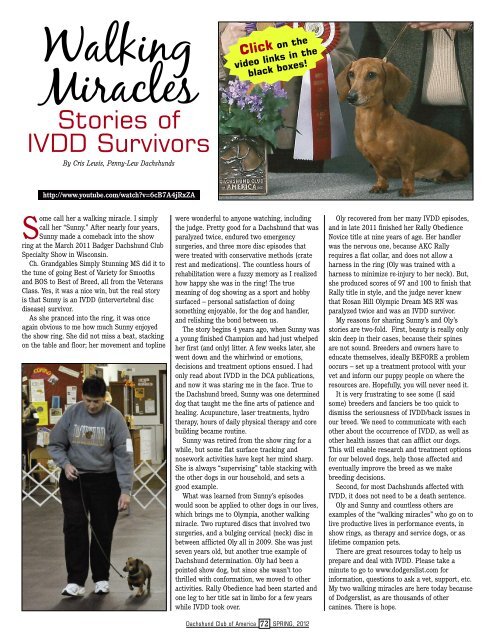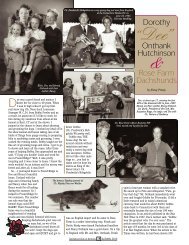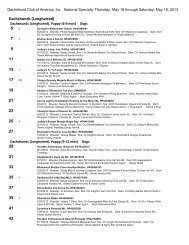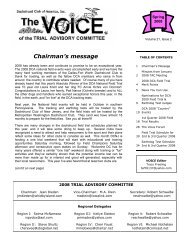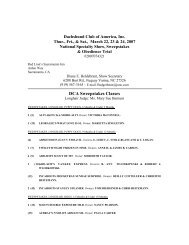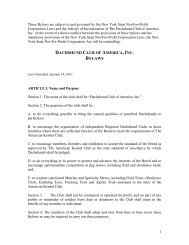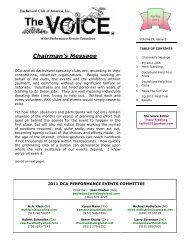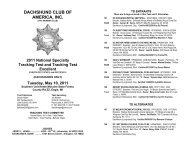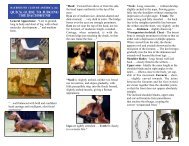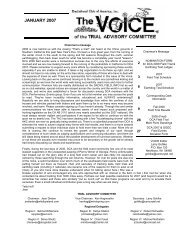Hope for IVDD Dogs - The Dachshund Club of America, Inc.
Hope for IVDD Dogs - The Dachshund Club of America, Inc.
Hope for IVDD Dogs - The Dachshund Club of America, Inc.
You also want an ePaper? Increase the reach of your titles
YUMPU automatically turns print PDFs into web optimized ePapers that Google loves.
Walking<br />
Miracles<br />
Stories <strong>of</strong><br />
<strong>IVDD</strong> Survivors<br />
By Cris Lewis, Penny-Lew <strong>Dachshund</strong>s<br />
http://www.youtube.com/watch?v=6cB7A4jRxZA<br />
Some call her a walking miracle. I simply<br />
call her “Sunny.” After nearly four years,<br />
Sunny made a comeback into the show<br />
ring at the March 2011 Badger <strong>Dachshund</strong> <strong>Club</strong><br />
Specialty Show in Wisconsin.<br />
Ch. Grandgables Simply Stunning MS did it to<br />
the tune <strong>of</strong> going Best <strong>of</strong> Variety <strong>for</strong> Smooths<br />
and BOS to Best <strong>of</strong> Breed, all from the Veterans<br />
Class. Yes, it was a nice win, but the real story<br />
is that Sunny is an <strong>IVDD</strong> (intervertebral disc<br />
disease) survivor.<br />
As she pranced into the ring, it was once<br />
again obvious to me how much Sunny enjoyed<br />
the show ring. She did not miss a beat, stacking<br />
on the table and floor; her movement and topline<br />
Click on the<br />
video links in the<br />
black boxes!<br />
were wonderful to anyone watching, including<br />
the judge. Pretty good <strong>for</strong> a <strong>Dachshund</strong> that was<br />
paralyzed twice, endured two emergency<br />
surgeries, and three more disc episodes that<br />
were treated with conservative methods (crate<br />
rest and medications). <strong>The</strong> countless hours <strong>of</strong><br />
rehabilitation were a fuzzy memory as I realized<br />
how happy she was in the ring! <strong>The</strong> true<br />
meaning <strong>of</strong> dog showing as a sport and hobby<br />
surfaced – personal satisfaction <strong>of</strong> doing<br />
something enjoyable, <strong>for</strong> the dog and handler,<br />
and relishing the bond between us.<br />
<strong>The</strong> story begins 4 years ago, when Sunny was<br />
a young finished Champion and had just whelped<br />
her first (and only) litter. A few weeks later, she<br />
went down and the whirlwind or emotions,<br />
decisions and treatment options ensued. I had<br />
only read about <strong>IVDD</strong> in the DCA publications,<br />
and now it was staring me in the face. True to<br />
the <strong>Dachshund</strong> breed, Sunny was one determined<br />
dog that taught me the fine arts <strong>of</strong> patience and<br />
healing. Acupuncture, laser treatments, hydro<br />
therapy, hours <strong>of</strong> daily physical therapy and core<br />
building became routine.<br />
Sunny was retired from the show ring <strong>for</strong> a<br />
while, but some flat surface tracking and<br />
nosework activities have kept her mind sharp.<br />
She is always “supervising” table stacking with<br />
the other dogs in our household, and sets a<br />
good example.<br />
What was learned from Sunny’s episodes<br />
would soon be applied to other dogs in our lives,<br />
which brings me to Olympia, another walking<br />
miracle. Two ruptured discs that involved two<br />
surgeries, and a bulging cervical (neck) disc in<br />
between afflicted Oly all in 2009. She was just<br />
seven years old, but another true example <strong>of</strong><br />
<strong>Dachshund</strong> determination. Oly had been a<br />
pointed show dog, but since she wasn’t too<br />
thrilled with con<strong>for</strong>mation, we moved to other<br />
activities. Rally Obedience had been started and<br />
one leg to her title sat in limbo <strong>for</strong> a few years<br />
while <strong>IVDD</strong> took over.<br />
<strong>Dachshund</strong> <strong>Club</strong> <strong>of</strong> <strong>America</strong> 72 SPRING, 2012<br />
Oly recovered from her many <strong>IVDD</strong> episodes,<br />
and in late 2011 finished her Rally Obedience<br />
Novice title at nine years <strong>of</strong> age. Her handler<br />
was the nervous one, because AKC Rally<br />
requires a flat collar, and does not allow a<br />
harness in the ring (Oly was trained with a<br />
harness to minimize re-injury to her neck). But,<br />
she produced scores <strong>of</strong> 97 and 100 to finish that<br />
Rally title in style, and the judge never knew<br />
that Rosan Hill Olympic Dream MS RN was<br />
paralyzed twice and was an <strong>IVDD</strong> survivor.<br />
My reasons <strong>for</strong> sharing Sunny’s and Oly’s<br />
stories are two-fold. First, beauty is really only<br />
skin deep in their cases, because their spines<br />
are not sound. Breeders and owners have to<br />
educate themselves, ideally BEFORE a problem<br />
occurs – set up a treatment protocol with your<br />
vet and in<strong>for</strong>m our puppy people on where the<br />
resources are. <strong>Hope</strong>fully, you will never need it.<br />
It is very frustrating to see some (I said<br />
some) breeders and fanciers be too quick to<br />
dismiss the seriousness <strong>of</strong> <strong>IVDD</strong>/back issues in<br />
our breed. We need to communicate with each<br />
other about the occurrence <strong>of</strong> <strong>IVDD</strong>, as well as<br />
other health issues that can afflict our dogs.<br />
This will enable research and treatment options<br />
<strong>for</strong> our beloved dogs, help those affected and<br />
eventually improve the breed as we make<br />
breeding decisions.<br />
Second, <strong>for</strong> most <strong>Dachshund</strong>s affected with<br />
<strong>IVDD</strong>, it does not need to be a death sentence.<br />
Oly and Sunny and countless others are<br />
examples <strong>of</strong> the “walking miracles” who go on to<br />
live productive lives in per<strong>for</strong>mance events, in<br />
show rings, as therapy and service dogs, or as<br />
lifetime companion pets.<br />
<strong>The</strong>re are great resources today to help us<br />
prepare and deal with <strong>IVDD</strong>. Please take a<br />
minute to go to www.dodgerslist.com <strong>for</strong><br />
in<strong>for</strong>mation, questions to ask a vet, support, etc.<br />
My two walking miracles are here today because<br />
<strong>of</strong> Dodgerslist, as are thousands <strong>of</strong> other<br />
canines. <strong>The</strong>re is hope.
Rhea’s Story<br />
By Lynne Dahlén<br />
Determination and perseverance should be<br />
Rhea’s registered name! Chazlyn’s Purely<br />
Providence SL was placed in pet home<br />
when she was 4 years old. She was shown a few<br />
times in the first four years she was with us,<br />
pointed, but I wasn’t thrilled with her rear<br />
movement and decided we shouldn’t breed her.<br />
She loved people, but was also one <strong>of</strong> those<br />
girls who wanted badly to be the “alpha bitch”<br />
http://youtu.be/VDBCSq2JOLU<br />
SAVING DOGS<br />
WITH SPINAL<br />
CORD INJURIES<br />
ScienceDaily (Jan. 18, 2012) — <strong>Dogs</strong> with spinal cord injuries may soon<br />
benefit from an experimental drug being tested by researchers at the<br />
University <strong>of</strong> Cali<strong>for</strong>nia, San Francisco (UCSF) and Texas A&M College <strong>of</strong><br />
Veterinary Medicine & Biomedical Sciences — work that they hope will<br />
one day help people with similar injuries.<br />
Funded through a three-year, $750,000 grant from the U.S. Department<br />
<strong>of</strong> Defense, the drug to mitigate damage has already proven effective in<br />
mice at UCSF. Now the Texas team will test how it works in previously<br />
injured short-legged, long torso breeds <strong>of</strong> dog like dachshunds, beagles<br />
and corgis, who <strong>of</strong>ten suffer injuries when a disk in their back<br />
spontaneously ruptures, damaging the underlying spinal cord.<br />
About 120 dogs a year that develop sudden onset hind limb paralysis<br />
after such injuries are brought to the Small Animal Hospital <strong>of</strong> Texas<br />
A&M University, where they receive surgical and medical treatment<br />
similar to that <strong>for</strong> human spinal cord injury. Now, researchers will test<br />
whether the new treatment works on some <strong>of</strong> these dogs, with their<br />
owners’ consent.<br />
“It would be phenomenal if it works,” said Linda J. Noble-Haeusslein,<br />
PhD, a pr<strong>of</strong>essor in the UCSF departments <strong>of</strong> Neurological Surgery and<br />
Physical <strong>The</strong>rapy and Rehabilitation Science who designed the<br />
intervention. “We are in a unique position <strong>of</strong> being able to treat a dog<br />
population where there are simply no current therapies that could<br />
effectively improve their hind limb function.”<br />
<strong>The</strong> new treatment does not seek to regrow injured pathways in the<br />
spinal cord. Instead, it aims to mitigate damage secondary to the spinal<br />
cord injury. Most spinal cord injuries trigger a cascade <strong>of</strong> chemical<br />
reactions in the spinal cord that collectively damage nearby cells and<br />
with the other girls in my pack. <strong>The</strong>y had<br />
different ideas. She was spending far too much<br />
time in her crate and, as gut-wrenching as it<br />
was to part with her, I felt she would be far<br />
happier as an “only” dog. She was spayed be<strong>for</strong>e<br />
she was placed.<br />
Fast <strong>for</strong>ward 4 years - I received a call from a<br />
friend saying 8 year old Rhea had gone down.<br />
Un<strong>for</strong>tunately, her owner didn’t call me<br />
immediately and we lost valuable treatment<br />
time. To make an extremely long story fairly<br />
short, the owner couldn’t af<strong>for</strong>d surgery and was<br />
not able to cope with a disabled dog. I owe a big<br />
thank you to many friends, and vets almost 300<br />
miles away who helped Rhea<br />
get proper treatment. After<br />
assesments by 4 different vets,<br />
my friend and also a vet, Dr.<br />
Peggy Orzel, brought Rhea to<br />
the Fox Valley Referral Center<br />
in Appleton, WI. <strong>The</strong> board<br />
certified surgeon, Dr. Bruce<br />
VanEnkevort, gave her an 85%<br />
chance <strong>of</strong> complete recovery<br />
after surgery to her C3 disk.<br />
<strong>The</strong> surgery went<br />
extremely well and<br />
the recovery was<br />
remarkable. Rhea<br />
was standing within<br />
48 hours after the<br />
<strong>Dachshund</strong> <strong>Club</strong> <strong>of</strong> <strong>America</strong> 73 SPRING, 2012<br />
surgery. 4 days later, Rhea’s breeder, Ellen<br />
Weiland, transported Rhea half way across the<br />
state where I picked her up and returned home<br />
to northern Wisconsin. Within just a few days<br />
she was attempting to walk, and she returned to<br />
normal quickly after minimal walking therapy.<br />
That was in February <strong>of</strong> 2011. A year later<br />
Rhea is running and playing (her buddies now<br />
are our 13 year old male Lhasa rescue and our<br />
little black house cat). We keep her separate<br />
from our other dachsies to avoid any “issues” (so<br />
much <strong>for</strong> no dogs upstairs!) One would never<br />
know she wasn’t able to walk at one time.<br />
As Cris stated, <strong>IVDD</strong> is not a death sentence<br />
and with education and proper care, our dogs<br />
can go on to live happy, healthy and long lives.<br />
Surgery is not the only option.<br />
As breeders, we all try to do our best to breed<br />
away from known back issues, but I’m sure the<br />
great majority <strong>of</strong> us who have had more than a<br />
few litters have had to deal with <strong>IVDD</strong> at one<br />
time or another. Rhea was the first in our 25<br />
years <strong>of</strong> limited breeding that has had a disc<br />
problem not attributed to an injury. Luckily, she<br />
never had puppies. Surgery is not the only<br />
option - but knowing where to find the resources<br />
to help a disabled pet is the first step. A<br />
Dodgerslist brochure should be included in each<br />
and every puppy packet we give to our new<br />
puppy owners.<br />
http://www.dodgerslist.com/<br />
pathways, contributing to functional deficits including hind limb function.<br />
A few years ago, Noble and her UCSF colleague Zena Werb, PhD,<br />
showed how blocking the action <strong>of</strong> one protein found in the spinal cord <strong>of</strong><br />
mammals can help mice recover from spinal cord injuries. This protein,<br />
called matrix metalloproteinase-9, can degrade pathways within the cord<br />
and cause local inflammation, leading to cell death.<br />
<strong>The</strong> injured dogs <strong>of</strong>fer a great opportunity to take the next step on this<br />
treatment because their injuries more closely mimic spontaneous human<br />
spinal cord injury and, as is the case with humans, no existing treatment<br />
has substantially reduced paralysis.<br />
Noble’s co-investigator on the new study, Jonathan Levine, DVM, an<br />
assistant pr<strong>of</strong>essor in neurology at Texas A&M University, will treat the<br />
dogs through injections <strong>of</strong> a protein-blocking drug. He will then help the<br />
dogs through rehabilitation and assess their recovery. Ongoing studies at<br />
UCSF focus on further refining delivery <strong>of</strong> the drug so as to optimize<br />
recovery.<br />
Other researchers have shown that movement can be preserved if as<br />
little as 18 percent to 20 percent <strong>of</strong> the nerve fiber tracts in the spinal<br />
cord remain intact.<br />
If successful, the trials in injured dogs may lead to the development <strong>of</strong><br />
similar treatments <strong>for</strong> people who suffer spinal cord injuries, Noble said.<br />
<strong>The</strong>se are among the most expensive injuries: every person with an<br />
injured spinal cord costs the health care system millions <strong>of</strong> dollars over<br />
his or her lifetime.<br />
Such costs <strong>of</strong>ten are overshadowed by the tragic and devastating<br />
personal price <strong>of</strong> the injuries, which dramatically alter lives and most<br />
<strong>of</strong>ten occur in younger people, with long lives in front <strong>of</strong> them. According<br />
to the National Spinal Cord Injury Statistical Center, based at the<br />
University <strong>of</strong> Alabama, Birmingham, most <strong>of</strong> the 12,000 <strong>America</strong>ns who<br />
suffer spinal cord injuries are between the ages <strong>of</strong> 16 and 30.<br />
As <strong>of</strong> this year, some 265,000 people in the United States are living<br />
with such injuries, according to the national center. This includes many<br />
wounded soldiers who have returned home from war zones.<br />
UCSF is a leading university dedicated to promoting health worldwide<br />
through advanced biomedical research, graduate-level education in the life<br />
sciences and health pr<strong>of</strong>essions, and excellence in patient care.


